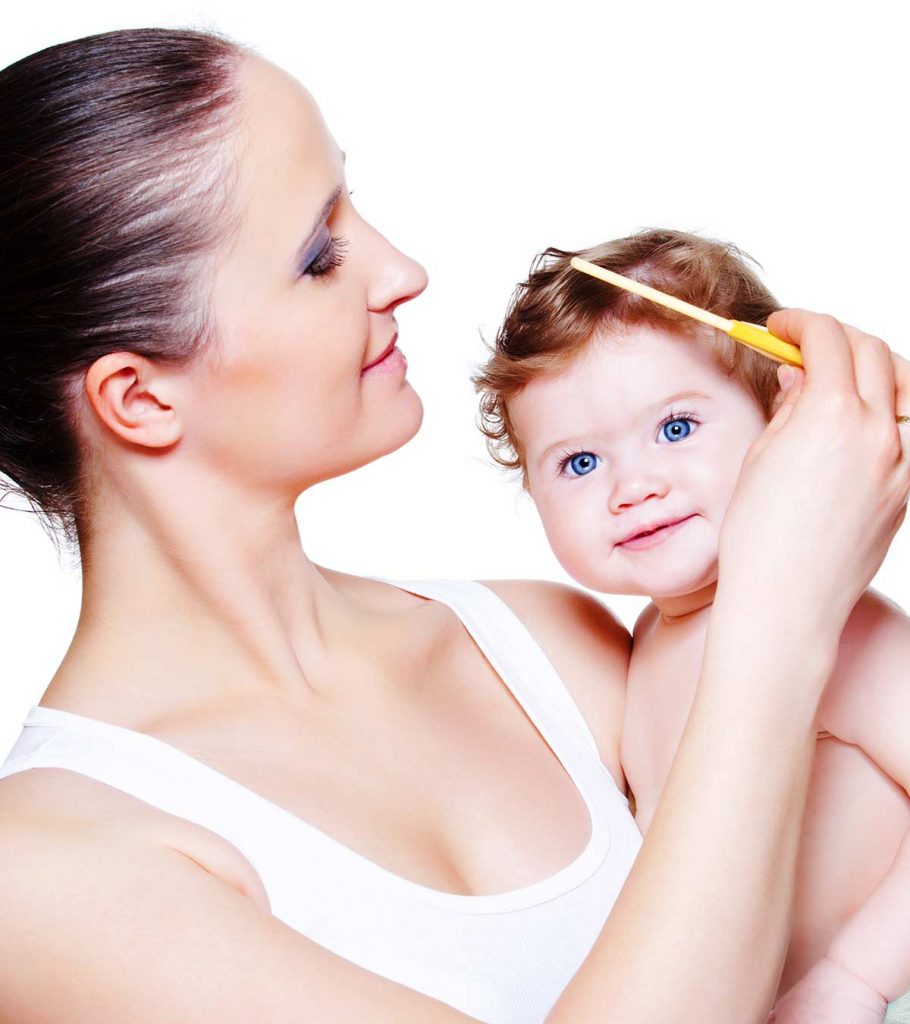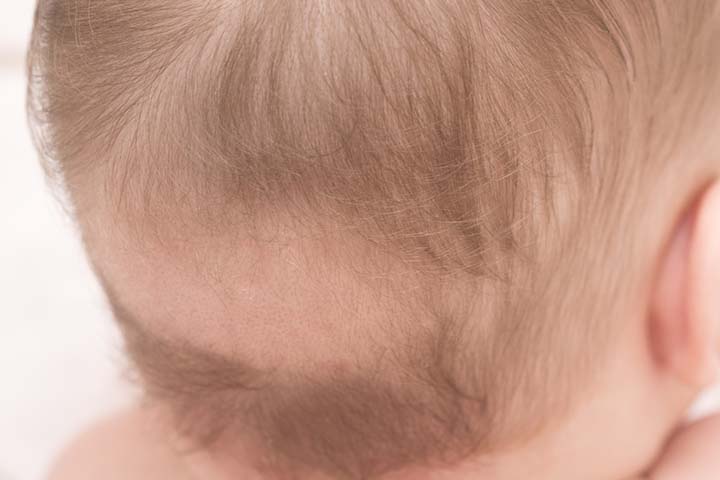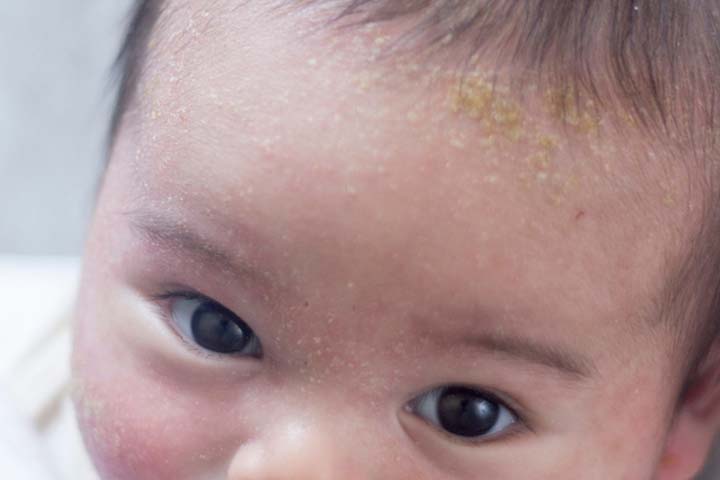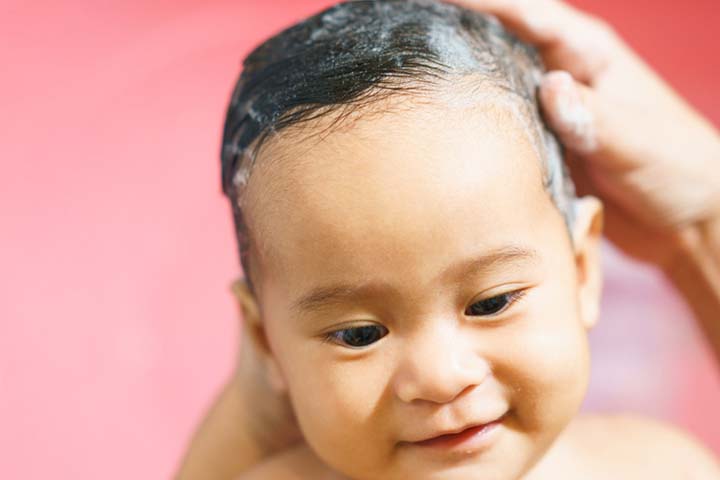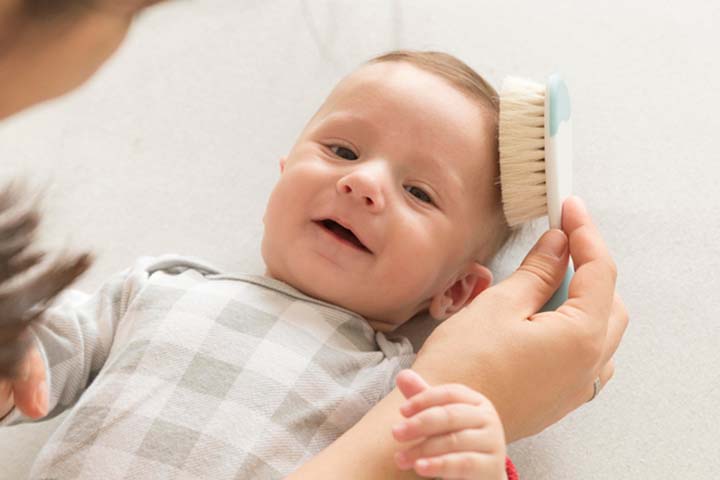Hair loss in babies is not commonly seen. Thus, it might be worrisome for some parents when they notice their little one’s hair falling at such an early age. However, studies suggest that infant hair loss is common, and infant hair will be replaced by adult hair as they grow. This phenomenon is known as alopecia.
Read on to know about the causes, signs, treatment, and prevention of hair loss in babies. This article also mentions some symptoms to look out for, along with hair loss, which may require medical attention.
Is It Normal For Babies To Have Hair Fall?
Hair loss in the first six months of life is normal for babies. Almost all newborns lose some or all of their hair before the mature hair follicles erupt (1). A newborn’s hormone levels drop right after birth, leading to loss of hair that the baby was born with. Scalp disorders can lead to hair loss in babies, making it important to maintain good scalp hygiene and treat any underlying conditions. Additionally, malnutrition can contribute to hair shedding and other hair-related issues in babies, making it essential to ensure they receive proper nutrition and a balanced diet. However, babies could also lose hair while rubbing their scalp against the mattress or as a result of a head caressing habit. Hair loss in babies could also happen as the baby starts to move.
In young babies, hair fall is common. But hair loss after the age of six months or a significant loss during the first six months could be an indicator of a dilemma.
Although, in rare cases, inherited autoimmune diseases such as alopecia since birth can be the main reasons for hair fall. This can occur by itself or in association with certain abnormalities of the nails and teeth. Later in childhood, hair loss could be due to medications, a scalp injury, a medical or nutritional problem, etc. Based on a collaborative study conducted by multiple institutions, pediatric alopecia areata impacts approximately 13.6 cases per 100,000 children. In such cases, a pediatric consultation is a wise option.
6 Possible Causes Of Hair Loss In Babies And Infants
The following are some of the most common causes of hair loss among infants (2):
- Constant friction: Babies spend a lot of time on their back and tummy till they can sit up. It is but normal for the head to come in contact with external surfaces. Repeated contact may lead to friction, which, if severe enough, could cause hair loss. Such hair loss is called friction alopecia or pressure alopecia. In such cases, hair loss usually ceases once the baby begins to sit and spends more time sitting than lying down.
- Scalp infections: Infections may be bacterial or fungal such as ringworm (tinea capitis), may cause hair loss among infants. Ringworm can cause circular patches of baldness on the baby’s scalp.
- Allergies: An allergic reaction of any form may lead to hair loss. A baby can be allergic to the massage oil that you apply to the scalp. Allergic conditions and eczema can also cause hair loss. A type of eczema that is commonly found on a baby’s head is seborrheic dermatitis, also called cradle cap (3).
Georgia Rose, a mother, describes the cradle cap’s impact on her baby’s hair. She says, “When she (her daughter) was three months old, she began to develop tiny bumps and scaly patches on her face, which felt dry and rough to touch. The doctor confirmed it as a cradle cap. It was around the same time that her hair started to fall out from the crown of her head. And, within a few days, all of her hair from the top fell out (i).”
- Repeated tugging of hair: If your baby tends to play with their hair or if there is a sibling who tugs the hair, then it could cause loss of hair. Psychological conditions such as trichotillomania, where the affected person likes pulling out hair, could be one of the reasons for it.
- Tight hairstyles: Braiding or tying the hair tightly is often a cause of hair loss in older infants and toddlers. Avoid binding the hair so tightly that it could damage the hair follicles and result in breakage and shedding of hair.
- Illness and stress: Underlying illness or a fever could make the hair follicle weak and lead to hair loss (4). Common causes of hair loss in children include telogen effluvium, tinea capitis, bacterial infections, traction alopecia, trichotillomania, and alopecia areata.
The causes of hair loss could be many. So, it is important to note the signs of hair loss among infants to manage it more efficiently.
What Are The Symptoms Of Hair Loss In Babies?
Here are the signs of severe hair loss in babies (2) (5):
- Too many hair strands in the comb: Perhaps the first indicator of hair loss would be excess hair in the teeth of your baby’s comb. If there are more than the usual number of hair strands, talk to the baby’s pediatrician.
- Hair all over the crib and toys: Excessive hair loss in babies can leave a trail of hair on things that the baby uses, from their crib to stuffed toys.
- Hair shed when you run fingers through them: You end up with tufts of hair between your fingers each time you run your fingers through the baby’s hair. This is most likely to happen in extreme cases of hair fall, such as chemotherapy if the child is suffering from any type of cancer.
- Bald patches on the scalp: You notice small or large circular zones of baldness or thin hair on the baby’s scalp. It is most common in conditions like ringworm, where the fungus invades only a part of the scalp, causing hair loss just in that area.
- Red, crusty, or inflamed scalp: The scalp appears red or crusty with flakes of yellowish skin shedding while you comb. The skin of the scalp also is particularly inflamed. These symptoms can indicate dermatitis or eczema.
Do You Have To Take The Baby To A Doctor For Hair Loss?
Hair loss in babies is not a medical emergency. If the baby is otherwise healthy, there is no need to take the baby to a doctor. However, if the baby has the following symptoms along with hair loss, then it is better for the doctor to take a look (2).
- Itchiness of the scalp
- Redness and inflammation
- A cracked and crusty scalp that bleeds
- Baby tends to pull hair very often
- Rapid hair thinning due to hair loss
- Blisters or pimples appear at the point of hair loss
- Fever
- Loss of appetite
The doctor may suggest a course of treatment depending on the symptoms shown by baby.
How Is Hair Loss In Babies Treated?
The treatment of hair loss will depend on the diagnosis of the underlying problem. Through examination of the scalp, the doctor will diagnose the reason for the hair fall. Treatment options for hair loss in babies include:
- Medicated baby-safe shampoos: If the doctor suspects an infection of the scalp, they may prescribe a medicated shampoo to clear the baby’s scalp of any pathogens that could have caused hair loss.
- Creams, lotions, and oils: Conditions like eczema of the scalp could be treated using creams that subdue inflammation. The doctor may also suggest lotions or baby oils that prevent the scalp from cracking, thus reducing hair loss.
- Anti-fungal ointments and medicines: Ringworm infections are treated with anti-fungal topical ointments. In severe cases of infection, your baby may be prescribed oral medications for faster relief.
- Use a soft bristle brush on your baby’s hair.
In some cases, you can prevent hair fall by taking a few simple precautions.
How To Prevent Hair Loss In Babies?
There is little you can do to prevent natural hair loss in babies aged less than six months. However, you can minimize the risk and slow down hair loss with proper hair care and a few precautions.
- Shampoo your baby’s hair periodically: Get a mild, baby-safe shampoo and wash the baby’s hair at least once in two days. You could also consult the pediatrician schedule that works the best for your baby.
- Avoid friction and tying baby’s hair too tight: Minimize scalp friction as much as you can and avoid tying the baby’s hair too tight. It reduces any strain on the hair follicles and thus reduces hair loss.
- Maintain good hygiene: Fungal infections often spread due to contact with soiled and dirty clothes such as towels and caps. Always wash the baby’s towels and clothes with warm water and baby-safe disinfectant detergent. Washing hands, after playing outdoors, also helps prevent fungal spores from infecting the skin.
- Be watchful of allergies: Allergic reactions often cause inflammation of the skin, including the scalp. Watch out for the signs of allergy, including symptoms such as skin hives and difficulty in breathing.
Hair loss in babies is harmless and does not usually indicate a health condition. It is normal for your baby to experience hair loss in the initial six months. However, in some cases, excessive hair falling accompanied by redness, fever, and appetite loss could indicate a more serious underlying condition such as a scalp infection. Otherwise, hair loss seldom has a severe consequence on the baby’s health, and you may have to wait a little longer for your baby to have strong, thick, and permanent hair, which is less prone to falling. Nevertheless, hormones and your baby’s genetic inheritance will surely impact their hair growth patterns.
Did your baby lose hair early on? How did you handle it? Share your story in the comments section below.
Key Pointers
- Hair loss in babies during the first six months is a common observation.
- Possible causes of hair loss include allergies, scalp infections, tight hairstyles, or medical ailments.
- Signs such as persistent itchy, red scalp, fever, or rapid hair thinning in babies require medical attention.
- Treatment for this condition includes medication, baby shampoos, and ointments.
- Minimizing scalp friction, washing the baby’s hair periodically, and keeping an eye out for allergies can help prevent hair loss.
Get your questions and confusions cleared about falling baby hair during the first few months by an expert in this video.
